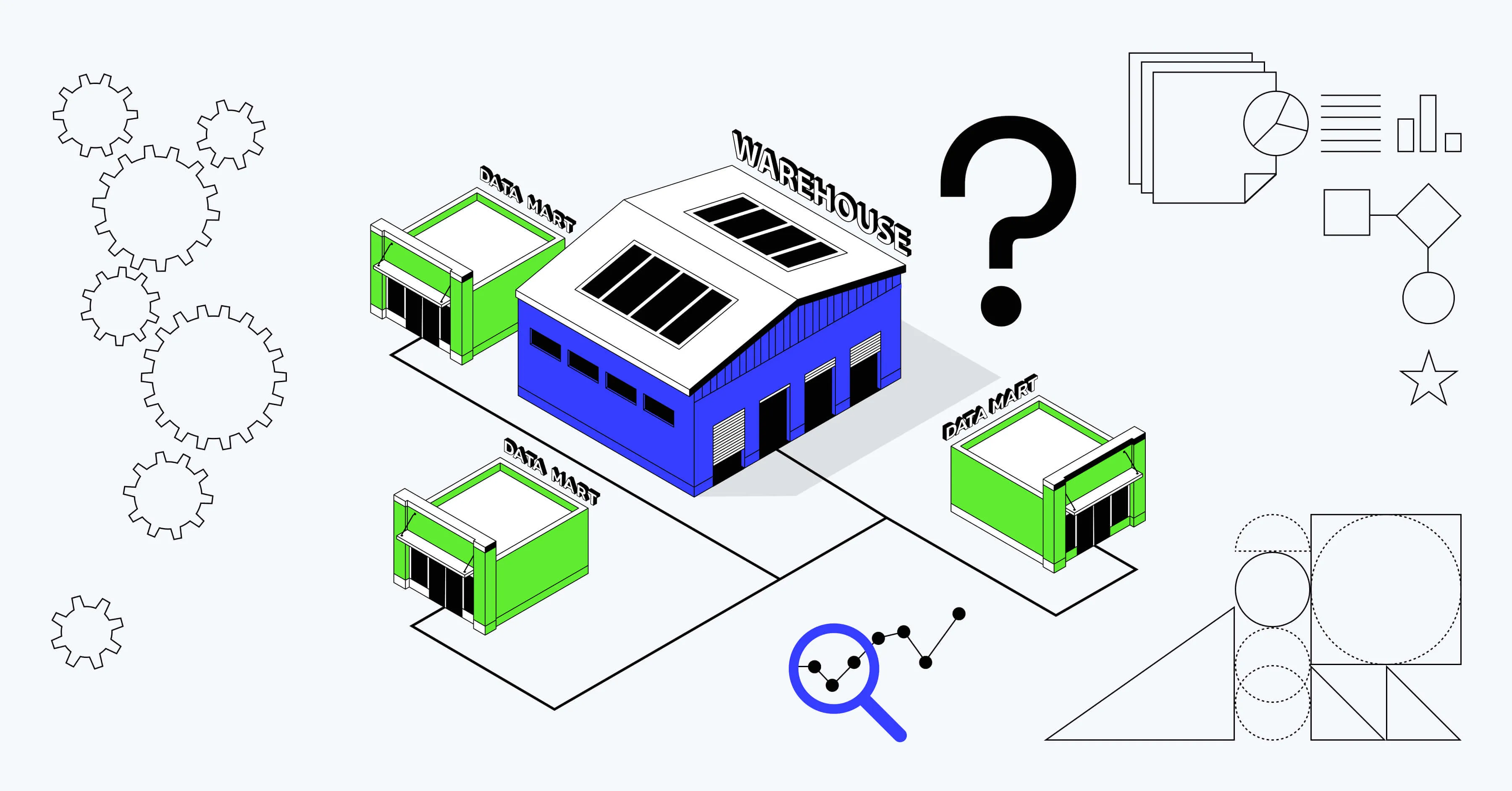What is an enterprise data warehouse?


Share
Whether you’re an early stage startup or a mature industry leader, you’re probably thinking about how you can use data to grow your business. Even if you already have data, you’re only halfway there. After all, your data may not mean much unless you have the right data infrastructure and analysis tools in place.
In this article, we’ll take a look at enterprise data warehouses and explore whether implementing one might be fruitful for your business.
Why do we need an enterprise data warehouse?
An enterprise data warehouse, or simply a data warehouse (DW), is a large database used for bringing together all company data.
Businesses, especially those with data-centric products, tend to ingest data from multiple heterogeneous sources. For example, an advertisement agency may ingest cross-channel information from social media, websites and mobile apps. Regardless of its source, this data is not necessarily useful straight away after you extract it. Before you can begin making sense of data, it needs to undergo various transformations.
Extracting and transforming data requires a lot of software engineering know-how, but figuring out how to optimally store and access data is a problem in and of itself.
If you have SQL experience, you know that working on even one database is not always simple. Now, imagine if you had to write a separate query for accessing each individual source—one for the data coming from server logs, another for a particular IoT device, and so on. You would easily be getting into hundreds of queries. This is not to mention all of the work required to merge all retrieved tables.
Even if you do all of the above correctly, you’re still at ground zero—all this work means you can only begin generating insights.
Enter data warehouses
Data warehouses address the issues of disorganized data sources and long analysis times by consolidating all company data sources in a single location. The technology underlying data warehouses is no different than that of any other database. However, because DWs unify all company data at one location, they simplify retrieving data and running complex queries. This allows analysts and data scientists to spend less time on mundane tasks like wrangling data, allowing them to be more productive and make more data-informed decisions.
Warehouses, lakes, marts…what’s the difference?
You might have noticed that data warehouses are often mentioned alongside data lakes and data marts, with the terms sometimes even used interchangeably. It’s not straightforward to provide a clear-cut definition of what each term denotes, especially since the differences are often blurred in practice. However, we can identify their key points of difference as having to do with intended usage, scale, and the way of structuring data.
Enterprise data warehouses
To recap, enterprise data warehouses combine all of your company data at a single location. The end-result is a data source that’s highly structured and easily accessible to everyone. Stakeholders can directly consume data from a DW to generate insights. Data warehouses employ an approach known as ETL, short for “Extract, Transform, and Load.” ETL dictates that once we extract raw data from a raw source, we need to transform it into the DW’s defined format before storing it.
Data lakes
Contrary to data warehouses, data lakes employ ELT, or “Extract, Load, and Transform.” Note the reversal of the “T” and “L” steps: data lakes store unprocessed data and only transform it upon analysis. Because data lakes store only unstructured data, those who aren’t used to working with unstructured data may find navigating data lakes difficult. Although this may seem like an unnecessary complexity, it allows data lakes to address the problems of data loss that DWs struggle with.
Indeed, data lakes are a more future-proof counterpart to DWs. As our data undergoes transformations, it inevitably loses some information. After all, this is one of the points behind transforming data. However, if some of this lost information later turns out to be important, there’s no way of retrieving it again. Data lakes overcome this problem by storing raw data. This allows businesses to hold on to their data until they prove its value and to change their queries, transformations, and strategy on the fly.
Additionally, data lakes are a better fit for companies that have a constant influx of large volumes of data. By supporting virtually every data type and skipping over the transformation step, data lakes are better suited for handling big data than data warehouses.
The unstructured nature of data lakes also brings its own set of challenges. For example, if the users are not proficient in SQL or if they’re not used to working with unstructured and unprocessed data, data lakes can bring about more questions than answers. What’s more, without proper data governance, data lakes can easily turn into data swamps.
Data marts
Lastly, data marts are essentially small, domain-specific data warehouses. Whereas an enterprise data warehouse contains information about all processes within all departments, a data mart may contain only information relevant to a particular department such as marketing or sales. Data marts are usually created from existing data warehouses. They make it even easier for users to fetch the data they need by alleviating the need to sift through the entire DW looking for the relevant subset. However, this is also their downside, as they cannot provide company-wide information.
Now that we’ve explained what an enterprise data warehouse is and is not, let’s delve into whether a data warehouse is the right fit for your business.
Should you implement an enterprise data warehouse?
There are a few things when deciding whether to implement an enterprise data warehouse.
Do you need a data warehouse or a data lake?
Data warehouses are created with a specific purpose in mind. Prior to building one, you need to be keenly aware of your internal processes, long-term strategy, and stakeholders’ needs. If you’re in the early stages of product innovation, you cannot truly know which data will turn out to be useful. In that case, a data lake may be a better fit than a data warehouse.
Is the scale of your business appropriate for a data warehouse?
If you’re a large enterprise, implementing a data warehouse is practically unavoidable. However, small and mid-size companies can get on without one. For example, if you’re integrating data from only a few sources, it may make sense to skip implementing a DW. Additionally, if running business intelligence tools in-house would cause your transactional systems to compete for processing power, performing analytics through tools like Google Analytics and Excel is a feasible option.
Do you work with multiple data sources?
Working with heterogeneous data sources inevitably leads to issues like:
- data inconsistency (e.g., departments producing conflicting results because they work on different data representations)
- redundancy (e.g., duplicates in data skewing the results)
- complications arising from different sources having different interfaces
- delayed insights due to routine activities occupying too much time
Working on multiple independent data sources without the ability to cross-analyze them is risky and inefficient. Data warehouses present a single source of truth for your data and allow departments like IT, data engineering and analytics to all work more productively. Implemented properly, data warehouses ensure that your team spends considerably less time on comparing numbers and generating reports.
Investing in a DW early on also ensures that organizing your data sources never becomes a logistical nightmare.
Implement an enterprise data warehouse with Mighty Digital
In this article, we reviewed key considerations related to enterprise data warehouses and covered whether implementing one would be a good fit for you.
If you’re looking to implement a DW for your organization, we at Mighty Digital would be happy to review your business’s requirements and use cases. Our data experts are ready to design a solution to take your business’s data effort to the next level.












